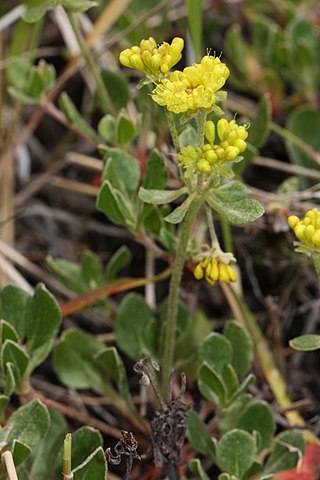
The El Segundo blue is an endangered species of butterfly. It is endemic to a small dune ecosystem in Southern California that used to be a community called Palisades del Rey, close to the Los Angeles International Airport (LAX).

Eriogonum fasciculatum is a species of wild buckwheat known by the common names California buckwheat and flat-topped buckwheat. Characterized by small, white and pink flower clusters that give off a cottony effect, this species grows variably from a patchy mat to a wide shrub, with the flowers turning a rusty color after blooming. This plant is of great benefit across its various habitats, providing an important food resource for a diversity of insect and mammal species. It also provides numerous ecosystem services for humans, including erosion control, post-fire mitigation, increases in crop yields when planted in hedgerows, and high habitat restoration value.

Euphilotes is a genus of butterflies in the family Lycaenidae, which consists of a number of species found in western North America. Some of the species are endangered, such as the Smith's blue, Euphilotes enoptes smithi.

Smith's blue butterfly, Euphilotes enoptes smithi, is a subspecies of butterfly in the family Lycaenidae. This federally listed endangered subspecies of Euphilotes enoptes occurs in fragmented populations along the Central Coast of California, primarily associated with sand dune habitat in one case with a dune-based Maritime Coast Range Ponderosa Pine forest in the Carbonera Creek watershed in Santa Cruz County. The range of E. e. smithi is from Monterey Bay south to Punta Gorda.

In biogeography, a native species is indigenous to a given region or ecosystem if its presence in that region is the result of only local natural evolution during history. The term is equivalent to the concept of indigenous or autochthonous species.

Eriogonum cinereum is a species of wild buckwheat known by the common names coastal buckwheat and ashyleaf buckwheat.

Eriogonum umbellatum is a species of wild buckwheat known by the common name sulphurflower buckwheat, or simply sulphur flower.

Boloria chariclea, the Arctic fritillary or purplish fritillary, is a butterfly of the family Nymphalidae. It is found in the northern parts of the Palearctic and Nearctic realms.

Eriogonum kennedyi is a species of wild buckwheat known by the common name Kennedy's buckwheat.

Calephelis perditalis, also known as the rounded metalmark or lost metalmark, is a species of butterfly in the family Riodinidae. It is found in Texas in the United States and Mexico, south to Venezuela. The species was first described by William Barnes and James Halliday McDunnough in 1918.

Euphilotes rita, the rita blue or desert buckwheat blue, is a species of butterfly of the family Lycaenidae. It is found in Wyoming, Colorado, Arizona, New Mexico and northern Mexico. The species was first described by William Barnes and James Halliday McDunnough in 1916.

Euphilotes battoides, the square-spotted blue or buckwheat blue, is a species of butterfly of the family Lycaenidae.

Euphilotes pallescens, the pale blue, pallid blue or pallid dotted blue, is a species of butterfly of the family Lycaenidae. It is found in the United States in southeastern California, Nevada, southern Utah and northern Arizona.

Euphilotes enoptes, the dotted blue, is a species of blue (Polyommatinae) butterfly in the family Lycaenidae. It is found in North America.
Euphilotes centralis, the central blue, is a butterfly in the family Lycaenidae. It was first described by William Barnes and James Halliday McDunnough in 1917. It is found in North America.

Euphilotes bernardino, the Bernardino blue, is a butterfly in the family Lycaenidae. The species was first described by William Barnes and James Halliday McDunnough in 1916. It is found in North America.

Euphilotes spaldingi, or Spalding's blue, is a butterfly of the family Lycaenidae. The species was first described by William Barnes and James Halliday McDunnough in 1917. It is found in North America.

Eriogonum elongatum, commonly known as longstem buckwheat or wand buckwheat, is a species of wild buckwheat native to coastal southern and Baja California.

















